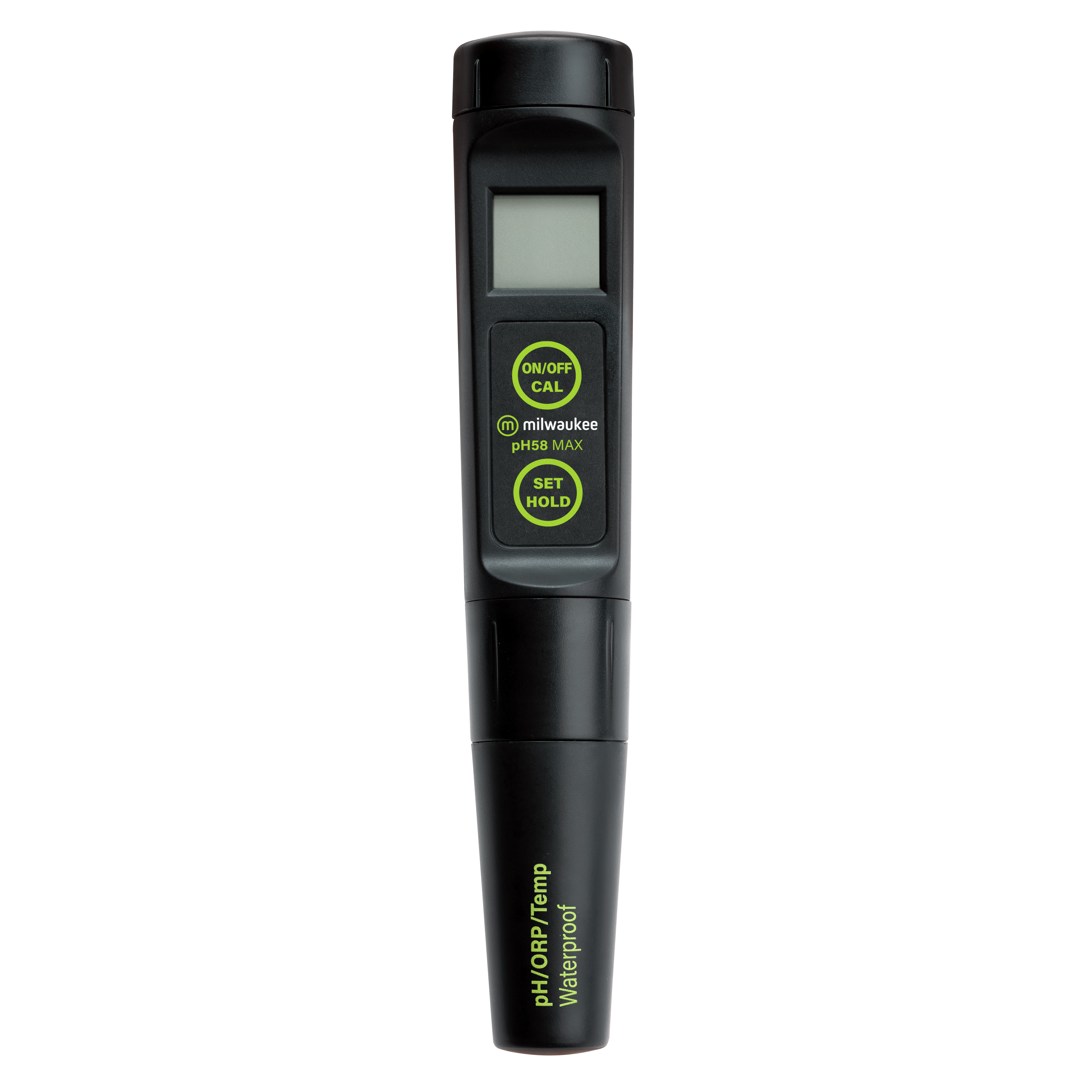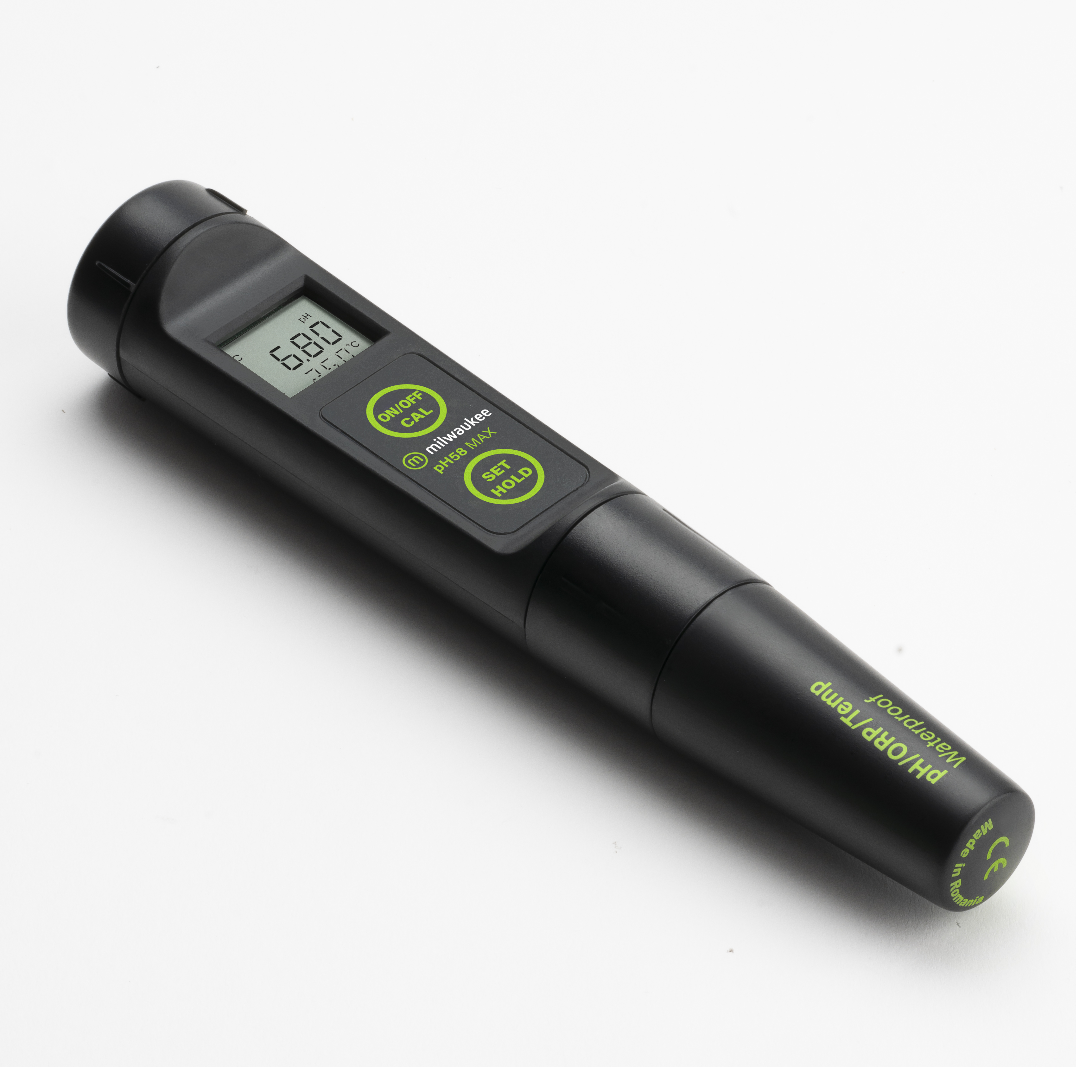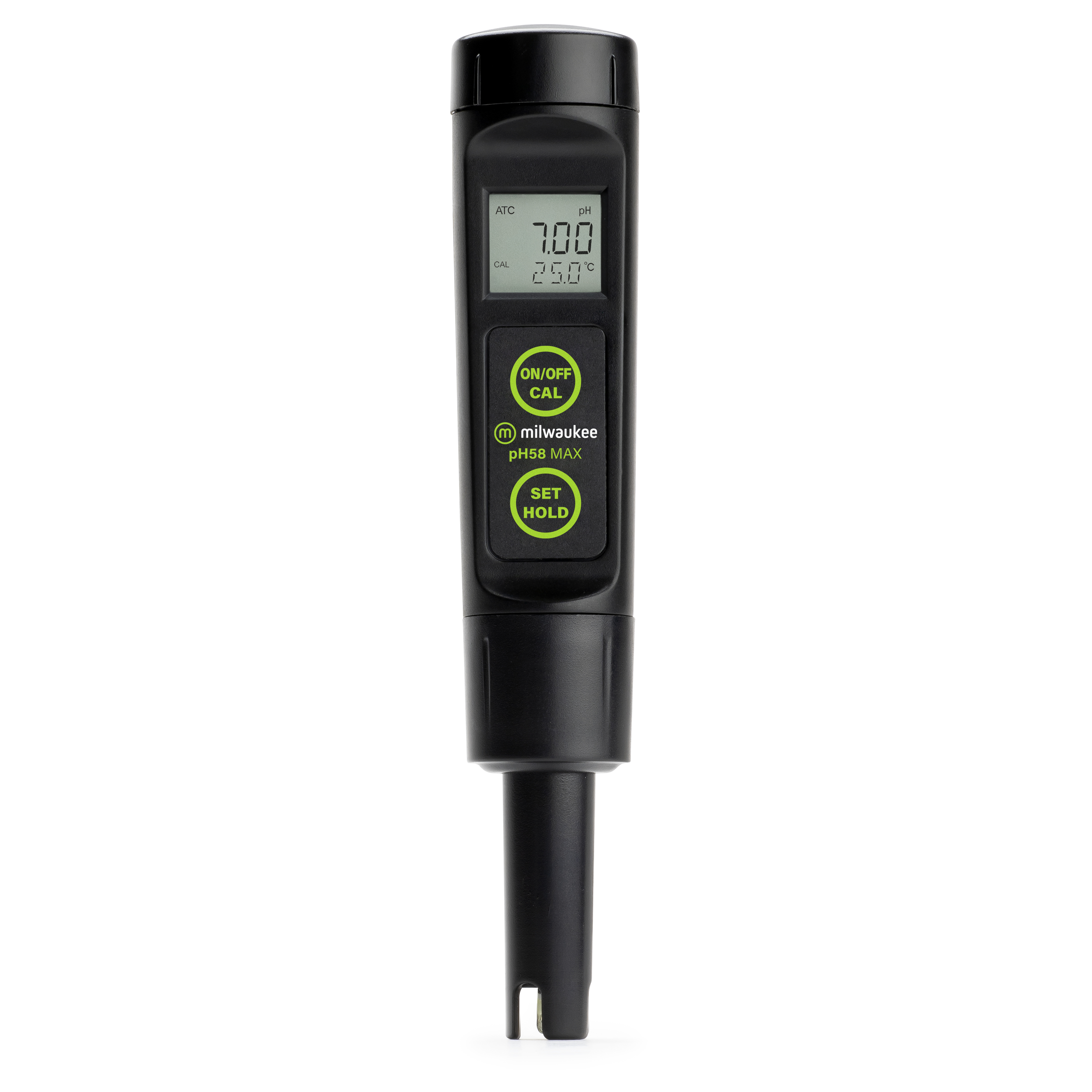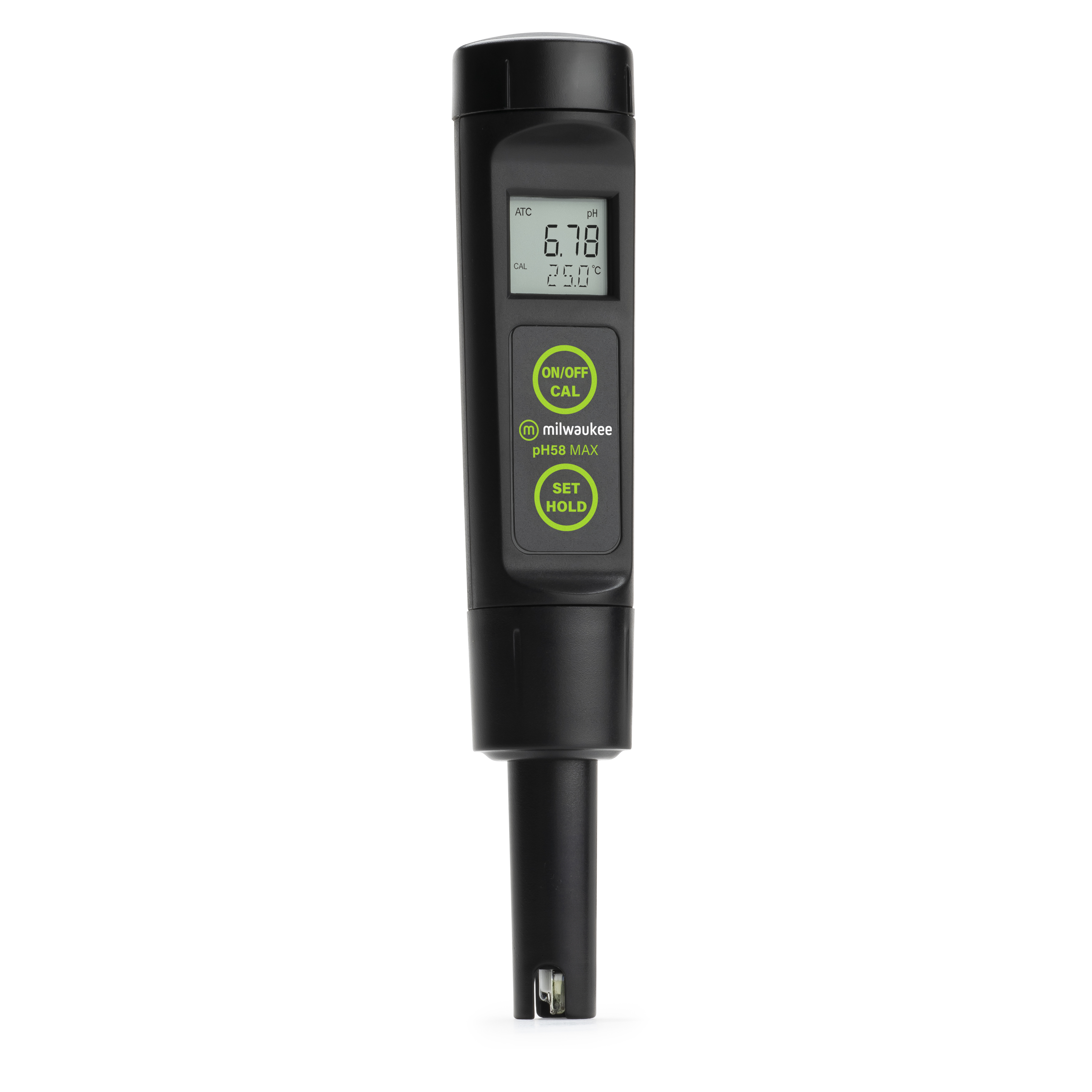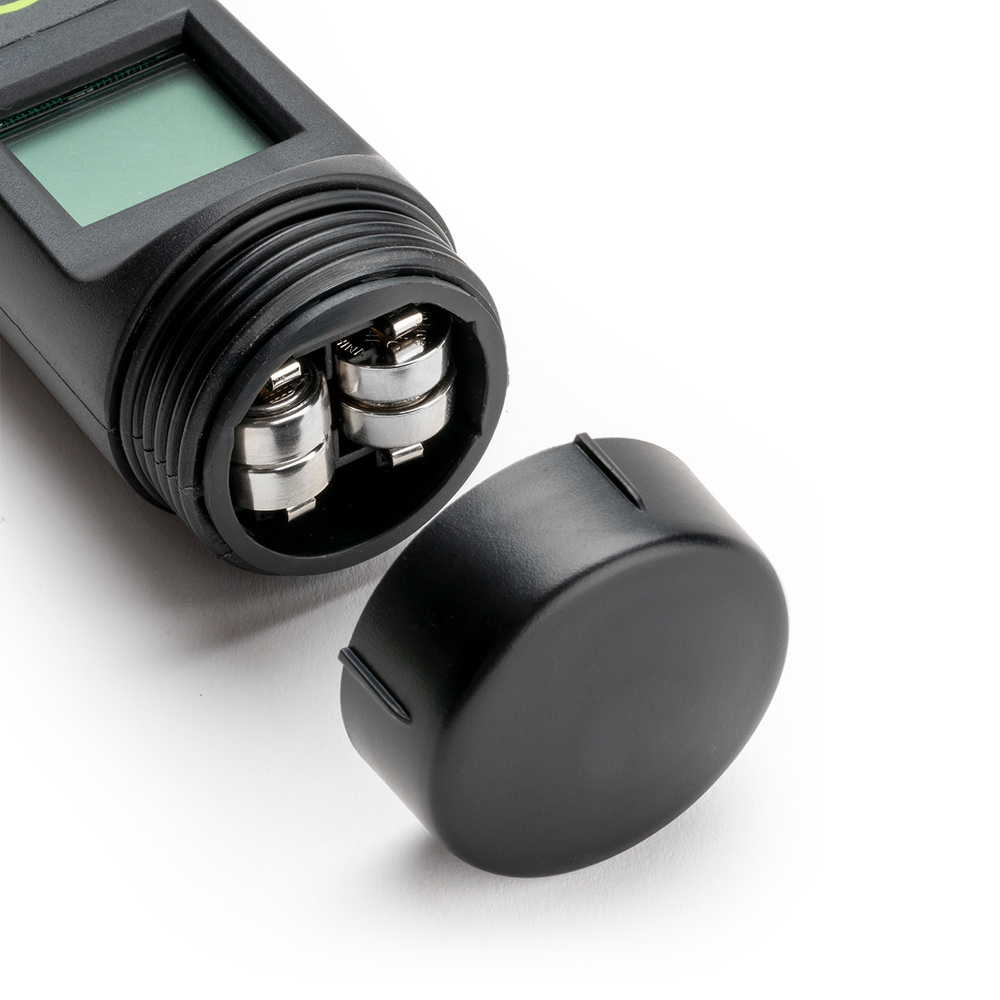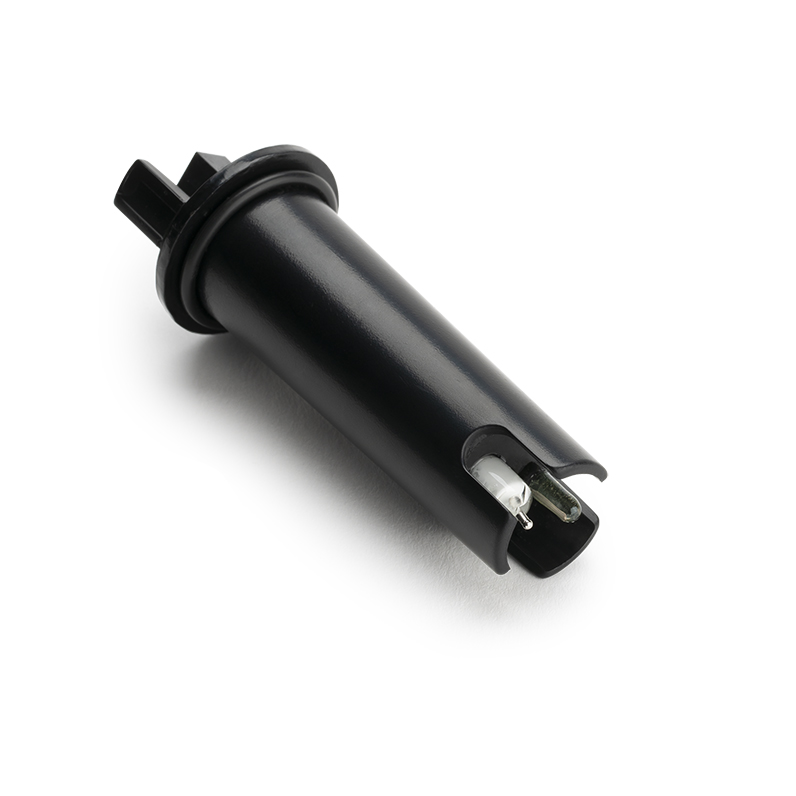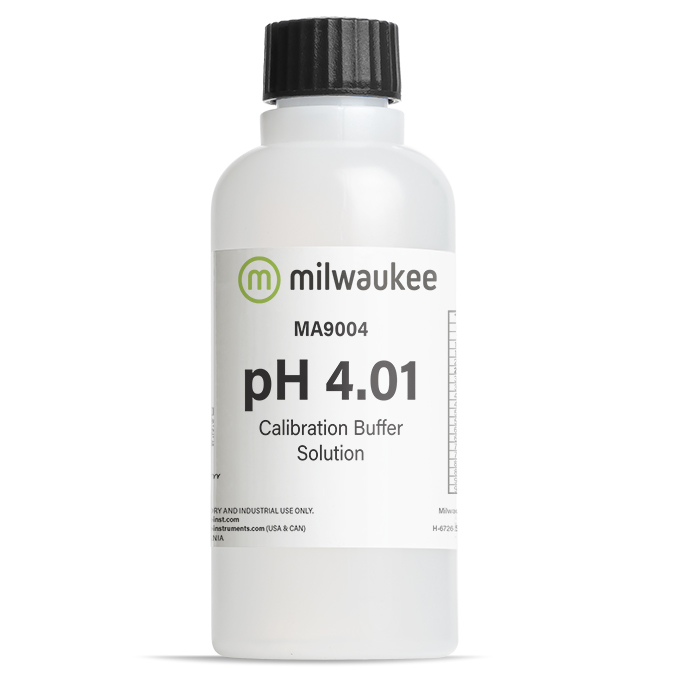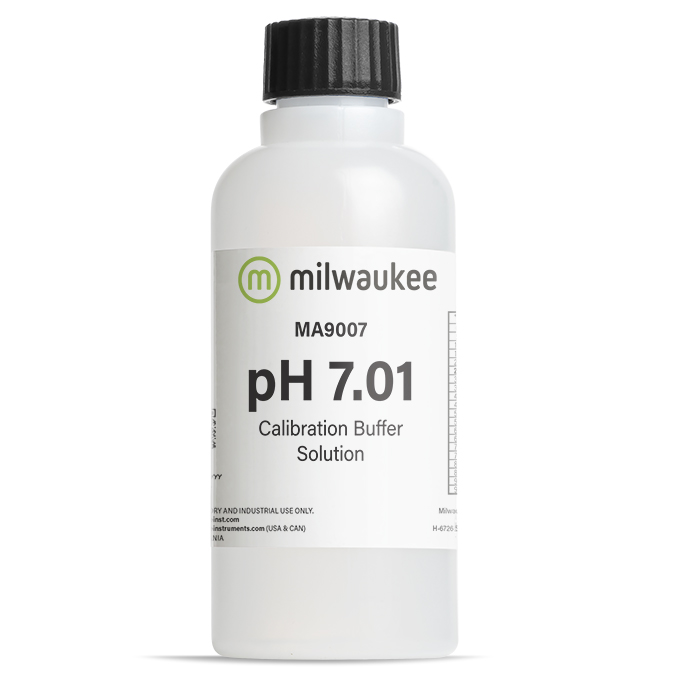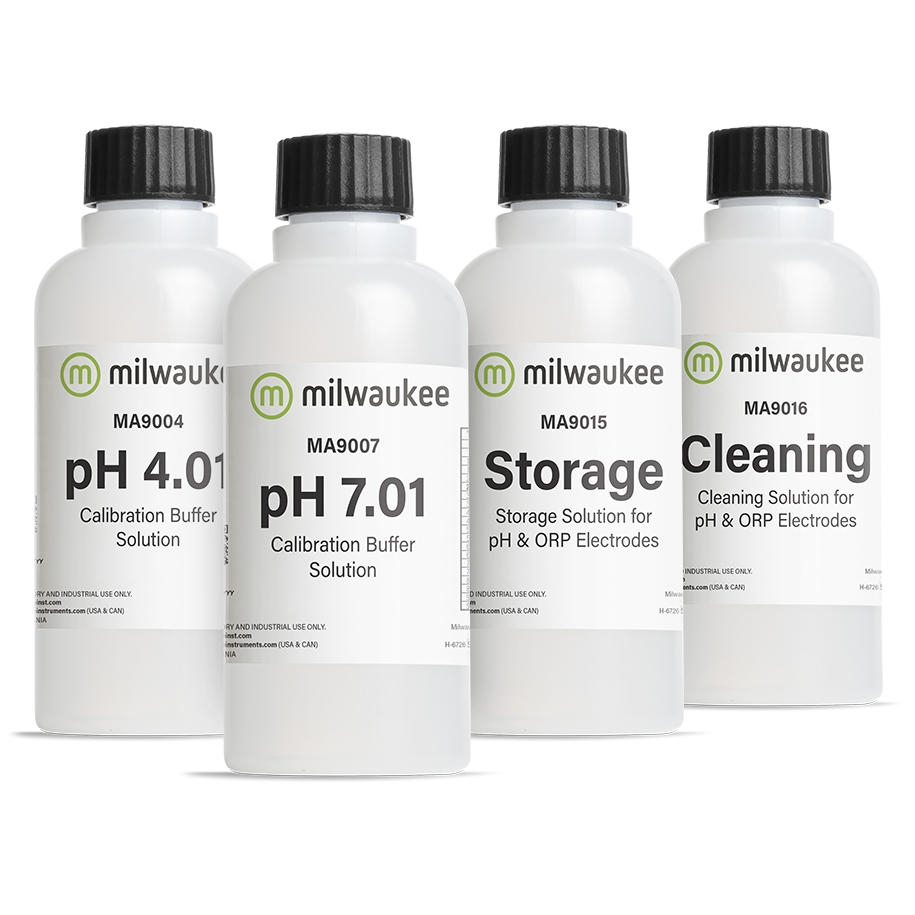Your shopping cart is currently empty.
€217.88
Milwaukee pH58 MAX Waterproof 3-in-1 pH/ORP/Temp Tester with Replaceable Probe
Milwaukee PH58 Waterproof pH/ORP/Temperature Tester – Reliable Pocket-Sized Precision for Water Quality on the Go
In the world of water quality management, precision and speed are non-negotiable – whether you're fine-tuning nutrient levels in a hydroponic system, balancing the delicate chemistry of a swimming pool, optimizing fermentation in winemaking, or ensuring safe, stable conditions in aquaculture or industrial processes. Even small fluctuations in pH or ORP (Oxidation-Reduction Potential) can have major consequences for crop health, fish welfare, sanitation effectiveness, or system performance.
The Milwaukee PH58 is engineered to give you fast, accurate, and consistent readings where they matter most – right at the source. This rugged, waterproof, and pocket-sized tester combines three critical parameters – pH, ORP, and temperature – into one easy-to-use instrument, giving you the control and confidence to make quick decisions with reliable data in hand.
Designed for professionals and serious hobbyists alike, the PH58 is built to perform in real-life environments: humid greenhouses, outdoor ponds, industrial cleaning lines, classroom labs, or anywhere that requires accurate testing on the move. Its compact form factor and intuitive interface make it ideal for one-handed field operation, while its automatic temperature compensation ensures your measurements are always correct – even when testing samples at varying temperatures.
The PH58 is more than just a tester – it’s a practical, everyday solution that fits in your pocket but delivers lab-grade accuracy. With a replaceable probe for long-term use and a floating, waterproof housing (IP65), it’s ready to go wherever your water testing takes you – from vineyard rows to wastewater tanks, from research benches to backyard koi ponds.
For anyone who needs fast, dependable water data without the bulk or complexity of traditional lab instruments, the Milwaukee PH58 is your essential go-to tool.
Why Choose the Milwaukee PH58?
- 3-in-1 Measurement: Simultaneously measure pH, ORP, and temperature – three critical indicators of water quality – in one compact, user-friendly instrument.
- High Accuracy, Fast Results: With ±0.05 pH accuracy and a ±2 mV ORP range, the PH58 gives you reliable data in seconds.
- Replaceable Probe Design: Extend the lifespan of your tester with a user-replaceable probe (model SE580), reducing long-term costs.
- Waterproof & Floating: Rated IP65 and able to float if dropped, the PH58 is ideal for field use in any environment – no stress over splashes or accidental submersion.
- Automatic Temperature Compensation (ATC): Ensures your readings stay precise even when testing water at varying temperatures.
- One- or Two-Point Calibration: Easy calibration options with standard buffers make it simple to maintain performance accuracy.
- Dual-Level LCD Display: View both the primary measurement and temperature on the same screen – quick data, no toggling needed.
- Long Battery Life: Enjoy up to 300 hours of operation on a single battery with low-power auto-off functionality.
Proper Care & Maintenance
To maximize accuracy and extend the life of your Milwaukee PH58:
- Rinse After Use: Always rinse the electrode with distilled water to remove residue, especially after testing dirty or chemically treated samples.
- Calibrate Regularly: Perform pH calibration with standard buffer solutions (pH 4.01 and 7.01) and check ORP accuracy with a known standard solution.
- Store Correctly: Keep the probe in a suitable pH storage solution when not in use. Never store the probe dry or in distilled/deionized water.
- Replace the Probe When Needed: If readings become slow or unstable despite calibration, replace the SE580 probe to restore accuracy.
- Avoid Cross-Contamination: Use care when moving between samples – clean the probe thoroughly to prevent misleading results.
Applications
The PH58 is perfect for use in a wide range of applications, including:
- Hydroponics & Greenhouses
- Aquaculture & Aquariums
- Swimming Pools & Spas
- Food & Beverage Production (e.g., fermentation)
- Environmental Field Testing
- Wastewater & Water Treatment
- Educational & Laboratory Use
Compact. Accurate. Waterproof.
Take your water testing to the next level with the Milwaukee PH58 – a reliable,
all-in-one solution for professionals and hobbyists who demand precision and
portability in any setting.
Specifications
Application
PH58 in Hydroponics & Greenhouses
Maintaining the right pH and ORP levels in a hydroponic or greenhouse environment is critical to plant health and nutrient absorption. Even slight imbalances can lead to nutrient lockout, root damage, or stunted growth. That’s why growers – whether hobbyists or commercial operators – rely on accurate, real-time water testing.
The Milwaukee PH58 gives hydroponic growers the power to measure pH, ORP (Oxidation-Reduction Potential), and temperature with a single, compact, waterproof device. With ±0.05 pH accuracy, it provides precise control over the nutrient solution, helping you achieve the ideal conditions for plant growth.
Why pH & ORP Matter in Hydroponics
· pH affects nutrient availability: Most plants thrive in the 5.5–6.5 range. Too high or too low, and key nutrients like nitrogen, phosphorus, and potassium become inaccessible to roots.
· ORP indicates water oxidation potential: High ORP values suggest good disinfection (useful when using ozone or chlorine), while low values may indicate biological activity or contamination.
· Temperature impacts plant metabolism and nutrient uptake: Warm water reduces oxygen content and increases the risk of pathogens, while cold water slows root activity.
The PH58 helps you monitor these values on the go – giving you the data you need to make immediate adjustments and avoid costly mistakes. Its replaceable probe ensures a long service life, even in nutrient-rich solutions that can wear out sensors faster.
How to Use the PH58 in Hydroponics
Preparation
· Calibrate your PH58 using pH 7.01 and 4.01 calibration solutions for best accuracy. For ORP, use a standard ORP solution (typically 220 mV or 470 mV).
· Rinse the probe with distilled water before and after each use to prevent contamination.
Measurement
1. Turn on the meter by pressing the ON/OFF button.
2. Insert the probe directly into your nutrient solution reservoir or sample container.
3. Stir gently to stabilize the reading. The dual display will show both pH (or ORP) and temperature values.
4. Wait for the stability indicator to appear, then take note of the readings.
5. Use the HOLD button if you want to freeze the result for recording.
Adjust as Needed
· If pH is too low or high, adjust with pH up/down solutions until your target range (typically 5.8–6.2) is reached.
· Monitor ORP if using sanitizing agents like ozone or hydrogen peroxide to ensure safe yet effective oxidation levels (usually 300–500 mV).
· Make sure temperature stays between 18–24 °C (65–75 °F), ideal for most hydroponic crops.
Aftercare
· Rinse the probe again with distilled water.
· Store the PH58 with the cap filled with storage solution (not water!) to preserve probe life.
PH58 in Aquaculture, Aquariums & Aquaponics
Whether you're running a commercial fish farm, maintaining a thriving home aquarium, or managing a sustainable aquaponic system, water quality is the foundation of success. Fish, plants, and beneficial bacteria all depend on balanced water chemistry – and even small fluctuations in pH, ORP, and temperature can quickly lead to stress, disease, or system failure.
That’s where the Milwaukee PH58 shines. This compact, waterproof tester gives you fast, reliable readings of three essential parameters – pH, Oxidation-Reduction Potential (ORP), and temperature – helping you detect problems early and maintain stable, healthy aquatic environments.
From hobbyists caring for ornamental fish to professionals raising tilapia or shrimp, the PH58 is a go-to tool for water monitoring. It combines lab-grade accuracy with on-the-go convenience, offering automatic temperature compensation, a replaceable probe, and a dual-display LCD – everything you need for daily system checks or deeper water diagnostics.
Why pH, ORP & Temperature Matter in Aquatic Systems
· pH affects fish health, plant nutrient uptake (in aquaponics), and microbial activity. Most freshwater species thrive between 6.5 and 8.0. Outside this range, fish can experience stress, poor digestion, and lowered immunity.
· ORP (Oxidation-Reduction Potential) measures the water’s ability to break down organic waste. A healthy ORP (typically 250–400 mV) indicates good water oxidation, meaning fewer pathogens and better clarity. In aquaponics, a balanced ORP supports healthy bacterial populations in biofilters.
· Temperature controls metabolic rates, oxygen solubility, and ammonia toxicity. Tropical aquariums, for example, require water between 24–27 °C, while aquaponic systems often aim for 18–24 °C to keep both fish and plants happy.
By tracking all three parameters with a single instrument, the PH58 allows you to respond quickly to changes – whether it's a pH swing after a feeding cycle or a drop in ORP that signals water fouling or equipment failure.
How to Use the PH58 in Aquaculture, Aquariums & Aquaponics
Calibrate for Accuracy
Before use, calibrate the PH58 for pH (using pH 7.01 and 4.01 buffer solutions) and ORP (using a standard ORP solution such as 220 mV or 470 mV). This ensures the readings are precise, especially when monitoring sensitive species or newly cycled systems.
Tip: Recalibrate weekly or after heavy use for best results.
Take Your Measurements
1. Turn on the tester and rinse the probe with distilled water.
2. Submerge the probe into the tank, pond, or sump. Avoid touching substrate or tank walls to ensure consistent readings.
3. Wait for the stability indicator to appear. The large display will show both pH/ORP and temperature values.
4. Press the HOLD button to freeze the reading if needed for documentation or adjustment purposes.
Pro tip: Always measure away from water inlets or aerators to avoid turbulence that could affect results.
Interpret and Act
· If pH is out of range: Adjust slowly with buffers or water changes. Sudden shifts are dangerous for fish and bacteria.
· If ORP is too low: Check for excess organic waste, poor filtration, or inadequate oxygenation. Clean filters or increase aeration.
· If temperature is too high or low: Adjust heaters or shade ponds. Consistent temps are key for both fish health and plant metabolism.
Clean and Store the Tester
· Rinse the probe with distilled water after each use.
· Store with the cap filled with pH storage solution (never dry or in pure water).
· Replace the probe (SE580) if readings become erratic or sluggish, especially after long-term use in nutrient-rich or high-waste environments.
Where It Shines
Fish Farms & Aquaculture Facilities – Maintain
optimal growth and prevent disease outbreaks.
Tropical & Cold-Water Aquariums – Keep sensitive species like discus
or koi in ideal conditions.
Aquaponic Systems – Balance the needs of plants, fish, and bacteria with
precision.
Healthy water = healthy life. With the Milwaukee PH58, you’re not just testing water – you’re building a stable ecosystem where aquatic life and plant growth can truly thrive.
PH58 in Swimming Pools & Spas
Crystal-clear water doesn’t happen by chance. Behind every pristine pool or relaxing spa lies a carefully managed balance of pH, ORP (Oxidation-Reduction Potential), and temperature – three essential parameters that affect water clarity, sanitation, comfort, and safety. If these values are off, even by a small margin, you can quickly face issues like cloudy water, skin and eye irritation, ineffective disinfection, or damage to your pool equipment.
The Milwaukee PH58 is the perfect portable solution for everyday water testing in both private and commercial pools and hot tubs. This 3-in-1 tester measures pH, ORP, and temperature with fast, accurate results, giving you the tools to monitor and adjust your water chemistry on the spot – without the guesswork of test strips or the complexity of large control systems.
Whether you’re a homeowner looking to keep your backyard pool balanced, a maintenance technician managing multiple installations, or a spa operator ensuring guest safety and comfort, the PH58 helps you keep your water clean, safe, and stable with lab-grade precision in your pocket.
Why pH, ORP & Temperature Are Critical in Pool & Spa Maintenance
· pH affects both water comfort and the effectiveness of chlorine. If pH is too low (acidic), it can cause corrosion and eye/skin irritation. If too high (alkaline), it can lead to cloudy water, scale formation, and reduced chlorine efficiency. The ideal range is typically 7.2 to 7.6.
· ORP measures the oxidizing power of your sanitizer (usually chlorine or bromine). A higher ORP (typically 650–750 mV) means better disinfection capacity. ORP is considered a more accurate reflection of sanitation than chlorine ppm alone, as it factors in how available the sanitizer is to destroy bacteria and viruses.
· Temperature impacts swimmer comfort and water chemistry. Warmer water can speed up sanitizer depletion and promote algae growth. Typical ideal temperatures:
Pools: 26–28 °C (78–82 °F)
Spas: 37–39 °C (98–102 °F)
Regularly monitoring these parameters helps prevent imbalances before they cause problems, ensuring a clean and enjoyable water experience for everyone.
How to Use the PH58 in Swimming Pools & Spas
Calibrate for Accuracy
Before testing, calibrate the PH58 using:
· pH buffer solutions (7.01 and 4.01 or 10.01 depending on expected range)
· ORP calibration solution (typically 220 mV or 470 mV standard)
Calibrate at least once a week for regular use, or before important measurements.
Take Your Measurement
1. Turn on the PH58 and rinse the probe with distilled water.
2. Submerge the probe directly into your pool or spa water. For more consistent readings, take the sample from elbow depth, away from jets, skimmers, or returns.
3. Allow the reading to stabilize. The LCD display will show pH/ORP and temperature readings simultaneously.
4. Press HOLD if needed to freeze the display and record the values.
Ideal targets:
· pH: 7.2 – 7.6
· ORP: 650 – 750 mV
· Temperature: 26–28 °C (pools) / 37–39 °C (spas)
Take Action if Needed
· If pH is too high, lower it using pH down (muriatic acid or sodium bisulfate).
· If pH is too low, raise it using pH up (sodium carbonate).
· If ORP is too low, add chlorine or check for organic contaminants, clogged filters, or high bather load.
· If temperature is outside range, adjust heating or shading as appropriate.
Clean and Store the Tester
· Rinse the probe thoroughly with distilled water after use.
· Store with the cap filled with storage solution (never dry or in pure water).
· Replace the SE580 probe when readings become unstable or slow to respond – especially if used in heavily chlorinated water over time.
Where It Works Best
Private backyard pools – Quick check after adding
chemicals or before swimming
Commercial pools & spas – Fast, portable tool for on-site staff
Wellness centers & hotels – Ensure hygiene and comfort for guests
Hot tubs & jacuzzis – Monitor small-volume, high-temperature water
systems
Stay ahead of water problems with the Milwaukee PH58 – compact, reliable, and built for the clarity, comfort, and confidence pool and spa users expect.
PH58 in Food & Beverage Production
From cheese-making and fermentation to sanitization and ingredient control, accurate pH and ORP monitoring is critical in food and beverage production. Quality, safety, and taste all depend on maintaining the right chemical conditions – whether you're brewing kombucha, curing meats, fermenting wine, or ensuring that your CIP (Clean-In-Place) systems are effective.
The Milwaukee PH58 Waterproof Tester is a compact, professional-grade tool designed to support food safety and production workflows. With the ability to measure pH, ORP (Oxidation-Reduction Potential), and temperature in one waterproof, easy-to-clean device, it offers reliable, on-the-spot testing in the most demanding environments. The replaceable probe makes it a cost-effective solution for industries that work with high-protein, acidic, or high-temperature samples, which can wear out sensors over time.
Whether you're a food safety technician, artisan cheesemaker, brewer, or beverage technologist, the PH58 helps you comply with HACCP and ISO standards by ensuring product consistency and process control – without the need for bulky lab equipment.
Why pH, ORP & Temperature Are Critical in Food & Beverage Applications
· pH affects everything from shelf life to flavor to food safety. In fermentation, pH indicates the progress of microbial activity. In cheese or yogurt making, it affects texture and curd formation. In meats or brining, pH helps control spoilage and enzymatic activity. Most regulatory bodies require precise pH tracking in critical control points (CCPs).
· ORP (Oxidation-Reduction Potential) is commonly used to assess sanitation effectiveness, especially in automated CIP systems. ORP values over 650 mV typically indicate strong oxidizing conditions – ideal for disinfecting equipment and surfaces. In fermentation, ORP can also be used to monitor microbial respiration.
· Temperature plays a major role in reaction speed, microbial growth, and food safety. For example, fermentation temperatures affect yeast behavior, while incorrect temperatures during sanitization or blending can spoil a batch.
The PH58 brings all three measurements together in a portable, durable, and user-friendly instrument – making it ideal for field sampling, tank checks, and in-line testing across the production line.
How to Use the PH58 in Food & Beverage Production
Calibrate for Reliable Results
Before use, calibrate the meter to ensure precision, especially if working with acidic or protein-rich samples:
· Use pH 7.01 and 4.01 buffers for calibration (or 10.01 if you expect alkaline values).
· For ORP calibration, use a standard 220 mV or 470 mV ORP solution.
Calibrate daily or before every series of measurements for best accuracy in food environments.
Prepare Your Sample
· Ensure the sample is at room temperature (or note the temp if you're measuring during a heated process).
· For semi-solid foods like cheese or dough, create a liquid slurry with deionized water for better probe contact.
· Clean off any oils, fats, or proteins from the probe before and after measurement.
Measure pH / ORP / Temp
1. Turn on the PH58 and rinse the probe with distilled or deionized water.
2. Insert the probe into the sample, ensuring good contact. For liquids, stir gently to stabilize readings.
3. Wait for the stability icon to appear, which confirms an accurate result.
4. Record the pH, ORP, and temperature shown on the dual LCD display.
5. Press HOLD to freeze the result for documentation if needed.
Common food-related targets:
· Cheese pH: 4.6–6.0 depending on type
· Kombucha ORP: ~+300 mV early fermentation, ~+100 mV as acids increase
· Sanitizing solutions: ORP ≥ 650 mV
Clean and Store the Probe
· Rinse thoroughly with distilled water, then clean with a mild enzymatic cleaner if oily or sticky residue is present.
· Store the probe in pH storage solution, never dry or in plain water, to maintain sensitivity.
· Replace the SE580 probe as needed, especially after frequent use in dairy, sugary, or acidic products.
Where the PH58 Excels in Food & Beverage
Dairy & Cheese Production – Monitor milk acidity
and curd formation
Fermentation (Beer, Wine, Kombucha) – Track microbial activity and
sanitation
CIP System Monitoring – Check sanitation efficiency via ORP
Pickling & Brining – Control acidity to prevent spoilage
Sauce & Dressing Production – Ensure product consistency and pH
balance
Quality Assurance Labs – Portable checks across production points
Reliable, accurate, and built for food-safe environments – the Milwaukee PH58 is a smart investment for any producer who values quality and compliance as much as taste.
PH58 in Environmental Field Testing
When it comes to understanding and protecting our environment, accurate water quality measurements are essential. Whether you're monitoring the impact of agricultural runoff, assessing the health of a freshwater stream, or conducting a baseline study for environmental compliance, having a reliable, portable, and easy-to-use instrument in the field is critical.
The Milwaukee PH58 Waterproof pH/ORP/Temperature Tester is purpose-built for environmental professionals who need to test on-site, often in remote or harsh outdoor conditions. With its waterproof, floating design, replaceable SE580 probe, and dual-line LCD display, the PH58 allows you to collect precise data in real time – without the bulk or fragility of lab instruments.
Designed to measure three vital parameters – pH, ORP (oxidation-reduction potential), and temperature – this tester gives you a snapshot of water chemistry that reflects both environmental quality and biological activity. Whether you're monitoring for pollution, conducting ecological research, or running government-mandated water assessments, the PH58 helps you make data-driven decisions right where nature demands it.
Why pH, ORP & Temperature Matter in Environmental Monitoring
· pH is one of the most fundamental indicators of water quality. It affects chemical solubility, nutrient availability, and the health of aquatic ecosystems. Most freshwater environments naturally range between 6.5 and 8.5, but sudden changes can indicate contamination, acid rain, or other environmental stressors.
· ORP (Oxidation-Reduction Potential) is a sensitive measure of water's ability to either break down pollutants or support microbial activity. High ORP (positive values) often signals good water quality and oxygenation. Low or negative ORP may suggest organic pollution, stagnant water, or chemical imbalances. ORP is especially useful in detecting changes in redox-sensitive ecosystems, wetlands, or during bioremediation processes.
· Temperature affects everything from dissolved oxygen levels to metabolic rates of aquatic life. It also influences the speed of chemical reactions and microbial processes. Knowing the temperature helps contextualize pH and ORP readings more accurately.
How to Use the PH58 in Environmental Field Testing
Prepare Your Meter
· Before heading to the field, fully charge the PH58, ensure it’s calibrated using certified pH 7.01 and 4.01 buffers, and ORP calibration solution (220 or 470 mV standard).
· If you'll be away from the lab for extended periods, pack extra calibration solutions and distilled water for rinsing.
Choose Your Sampling Location
· Select sites away from active flow disturbances (e.g., waterfalls, dams) unless specifically monitoring turbulence effects.
· Note GPS coordinates and ambient conditions (weather, recent rain, etc.) to log with your measurements.
Take Your Measurement
1. Turn on the PH58. Rinse the probe in distilled water, then shake off excess liquid.
2. Submerge the probe into the waterbody or sample container at a depth of 10–20 cm below the surface.
3. Wait for the readings to stabilize (use the HOLD function to freeze the result if needed).
4. The display will show:
· pH value (top)
· ORP (mV) (bottom, switchable)
· Temperature (°C/°F) on the right
Tip: For more consistent data, take readings at the same depth and time of day at each site, and avoid areas near debris or heavy algae.
Record and Rinse
· Log the values manually or via your environmental monitoring app, including date, time, location, and weather conditions.
· Rinse the probe with distilled water before moving to the next site to avoid cross-contamination.
End of Day Maintenance
· After fieldwork, rinse the electrode thoroughly, and if heavily soiled, clean gently with electrode cleaning solution.
· Recalibrate if needed and store the probe in storage solution—never dry or in tap water.
Typical Environmental Applications of the PH58
Stream & river health monitoring – Track pH
shifts from acid rain, pollution, or seasonal changes
Wetland studies – Observe ORP fluctuations related to oxygenation,
microbial activity, or nutrient cycling
Urban runoff & stormwater assessments – Spot chemical imbalances and
pH/ORP indicators of contamination
Agricultural water management – Check for pH/ORP changes due to
fertilizers, pesticides, or manure runoff
Environmental education & field labs – A rugged and easy-to-use tool
for students and citizen science projects
Site remediation projects – Monitor redox status and chemical conditions
during bioremediation or cleanups
Built for real-world fieldwork, the Milwaukee PH58 gives environmental professionals the power to test, trust, and take action – all from the palm of your hand.
PH58 in Wastewater & Water Treatment
Accurate monitoring of pH, ORP, and temperature is essential in both municipal and industrial wastewater treatment processes. Whether you're neutralizing effluents, controlling disinfection, or managing biological treatment stages, the Milwaukee PH58 Waterproof pH/ORP/Temperature Tester delivers fast, accurate, and portable measurements in demanding conditions.
In wastewater systems, pH affects chemical dosing, sludge processing, and biological activity. ORP is widely used to assess oxidation-reduction conditions – critical for aerobic digestion, denitrification, and disinfection monitoring. With a replaceable probe, waterproof housing, and dual-line display, the PH58 is designed for reliable field or plant-side use, even in harsh, wet environments.
For plant operators, technicians, and environmental engineers, the PH58 offers a convenient way to verify inline sensor accuracy, spot-check process values, or monitor smaller systems where fixed controllers aren't practical.
Why pH, ORP & Temperature Matter in Water Treatment
· pH control is vital in processes like:
o Neutralizing acidic or alkaline discharges
o Optimizing flocculant and coagulant effectiveness
o Maintaining stable conditions for biological treatment (typically pH 6.5–8.5)
· ORP (Oxidation-Reduction Potential) is a fast and insightful indicator of redox conditions:
o Positive ORP (> +200 mV): indicates oxidizing conditions (ideal for chlorine disinfection, aerobic digestion)
o Negative ORP (< 0 mV): signals reducing conditions (useful for anaerobic digestion or sulfide control)
o ORP > +650 mV is often required for effective chlorine-based disinfection
· Temperature impacts reaction rates, microbial efficiency, and gas solubility. Accurate temp readings help operators adjust treatment strategies accordingly, especially in seasonal or outdoor systems.
By combining all three parameters, the PH58 provides a complete snapshot of process water chemistry, helping facilities stay within regulatory limits, improve efficiency, and reduce chemical costs.
How to Use the PH58 in Water & Wastewater Applications
Calibrate the Instrument
· Perform calibration before each shift or field series to ensure accuracy.
o Use pH 7.01 and 4.01 buffers for calibration.
o Use ORP standard solution (e.g., 220 mV or 470 mV) for ORP sensor calibration.
· Allow the device to stabilize at ambient plant temperature for best results.
Prepare for Sampling
· Rinse the probe with distilled water to avoid contamination.
· For in-plant checks:
o Collect a grab sample from process tanks, effluent lines, or clarifiers.
o For field use: immerse the probe directly in manholes, sampling wells, or aeration basins (if safe and appropriate).
Take the Measurement
1. Submerge the probe in the sample, ensuring full coverage of the sensor.
2. Wait for the stability icon to appear.
3. Read:
· pH (top display)
· ORP in mV (bottom)
· Temperature (right side of display)
4. Use the HOLD function to freeze values for manual logging or compliance reports.
Tip: When testing high-solids or foamy samples, gently stir or move the probe to avoid surface bubbles or inconsistent contact.
Clean and Store
· After testing, rinse the probe with distilled water to prevent buildup.
· If fouled by sludge or biofilm, gently clean with electrode cleaning solution.
· Always store the pH sensor in storage solution (not dry or in tap water).
Where PH58 Excels in Water & Wastewater Monitoring
Primary treatment – Check incoming pH and ORP before
neutralization or screening
Biological reactors – Monitor conditions for
nitrification/denitrification
Sludge processing – Ensure suitable pH for digestion, dewatering, or
lime stabilization
Effluent discharge – Verify compliance with regulatory pH and oxidation
targets
Disinfection stages – Confirm ORP levels for effective
chlorine/chloramine activity
Industrial pretreatment – Monitor process water from food, pharma, or
chemical plants before discharge
Compact, durable, and ready for harsh environments, the Milwaukee PH58 is the go-to handheld tester for water treatment professionals who need fast, reliable results wherever the job takes them.
PH58 in Educational & Laboratory Use
Whether in a high school chemistry lab, a university environmental science program, or a technical training institute, the Milwaukee PH58 Waterproof pH/ORP/Temperature Tester offers an ideal blend of hands-on learning, precision, and reliability. It's designed to help students, educators, and researchers understand the essential principles of water chemistry through direct measurement of pH, oxidation-reduction potential (ORP), and temperature – three of the most fundamental and instructive parameters in liquid analysis.
The PH58's clear digital display, simple operation, and replaceable electrode make it especially suitable for repeated classroom use, student-led experiments, and introductory-level training in water quality analysis. For laboratory researchers, it provides a fast and reliable way to perform routine spot checks, verify experimental conditions, or support process development with accurate field-style instrumentation.
This compact meter encourages learners to explore real-world chemical processes – from acid-base reactions and redox chemistry to environmental impacts on water systems – while offering educators a dependable tool that stands up to daily use.
Why the PH58 is Ideal for Education and Laboratory Work
· Hands-On Learning: Perfect for teaching key chemistry concepts like pH balance, redox reactions, and temperature influence on solubility and reactivity.
· Dual pH & ORP Measurement: Allows students and researchers to compare how oxidation-reduction conditions change with pH and temperature.
· User-Friendly Display: Dual-line LCD screen makes it easy to see two parameters at once – great for demonstrating real-time interactions during class.
· Replaceable Electrode (SE580): Extends the product's life in busy classroom labs while reducing maintenance costs over time.
· Rugged and Waterproof: Built to withstand spills, drops, and everyday student use without compromising accuracy.
Educational Experiments & Lab Applications
Acid-base titrations – Use the PH58 to monitor pH
during stepwise addition of acid or base
Redox studies – Track ORP changes during oxidation/reduction experiments
(e.g., iron, chlorine reactions)
Temperature effect on pH – Study how heating or cooling affects
dissociation and solution pH
Biochemical experiments – Monitor media pH and redox status in
fermentation or enzyme activity labs
Aquatic science labs – Analyze the pH and ORP of tap, pond, or bottled
water in field kits or practicals
Electrochemistry demonstrations – Show how chemical potential is linked
to measurable mV values with ORP
How to Use the PH58 in Education & Lab Settings
Calibrate the Meter Before Use
· Always begin your lab session with calibration to ensure accurate results.
o Use pH 7.01 and 4.01 buffer solutions for pH.
o Use a certified ORP standard solution (commonly 220 mV or 470 mV) for ORP.
· Calibration only takes a few minutes and reinforces good lab practices for students.
Prepare for Testing
· Rinse the electrode with distilled water to remove storage solution or previous sample residue.
· If you're testing a classroom-prepared solution, gently swirl or mix to ensure uniformity before measuring.
Take the Measurement
5. Turn on the PH58 and submerge the probe into the liquid, ensuring the sensor is fully immersed.
6. The dual-line screen will show:
· Top: pH value
· Bottom: ORP (in mV) or switch to temperature reading
· Side: Temperature (°C/°F)
7. Wait for the values to stabilize before recording the results.
8. Use the HOLD function to freeze the display if needed when showing students or recording data.
Pro Tip for Teachers: Demonstrate how temperature affects pH by heating or cooling a buffer and watching the pH reading change – an excellent visual for understanding dissociation and equilibrium.
Clean and Store the Electrode
· After each use, rinse the probe with distilled water.
· At the end of class or lab session:
o If the probe is dirty, use electrode cleaning solution.
o Recalibrate if used extensively.
o Always store the pH electrode in proper storage solution – never let it dry out.
Why Educators & Researchers Choose the PH58
· Reliable Classroom Tool – Durable enough for repeated student handling while delivering professional-level accuracy.
· Quick Spot-Checking – Ideal for small labs and institutions where a portable, all-in-one meter is more practical than benchtop systems.
· Excellent Training Device – Teaches future scientists and technicians the fundamentals of electrochemical testing, data logging, and calibration.
· Budget-Friendly – Offers a complete water chemistry testing solution without the high price tag of full lab meters.
From the chemistry lab to the environmental science classroom, the Milwaukee PH58 empowers the next generation of scientists with the tools they need to explore, experiment, and understand water chemistry – accurately and confidently.



